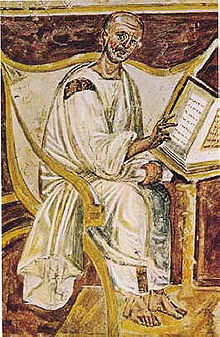De Trinitate
De Trinitate is Augustine's main philosophical work. Augustine had been working on it since about 400 and only completed it between 417 and 428. In terms of argumentative power and importance, it ranks equally alongside De civitate Dei and the Confessiones . His work documents the end of the ancient way of thinking and living.
structure
The work is divided into fifteen books. The first book deals with the evidence of the unity and equality of the three divine Persons through Scripture. In doing so, he tries to interpret some of the scriptural texts that seem to speak against the equality of the son with the father.
Legend
The legend of Augustine and the boy by the sea has been associated with the book since the Middle Ages .
Latest edition
- De trinitate . Latin – German. Newly translated and edited with an introduction by Johann Kreuzer (= Philosophical Library 523). Felix Meiner, Hamburg 2003. ISBN 978-3-7873-1651-9 .
literature
- Basil Studer : Augustine. De Trinitate. An introduction . Schöningh 2006. ISBN 978-3-506-71395-7 .
- Roland Kany: Augustine's Trinity Thinking. Review, criticism and continuation of modern research on “De trinitate” (= studies and texts on antiquity and Christianity, vol. 22). Tübingen 2008, ISBN 978-3-16-148326-4 .
- Johannes Brachtendorf: The structure of the human spirit according to Augustine. Self-reflection and knowledge of God in “De trinitate” (= Paradeigmata , Volume 19). Meiner, Hamburg 2000, ISBN 3-7873-1435-0 (habilitation thesis Universität Tübingen 1998, 335 pages).
Web links
Wikisource: De trinitate (Aurelius Augustinus) - Sources and full texts (Latin)
